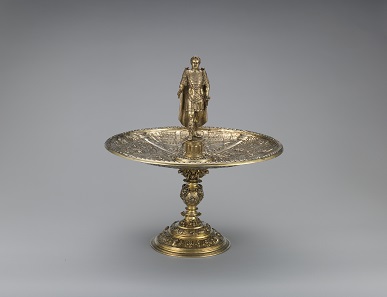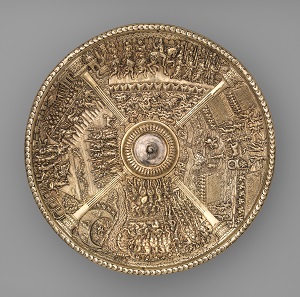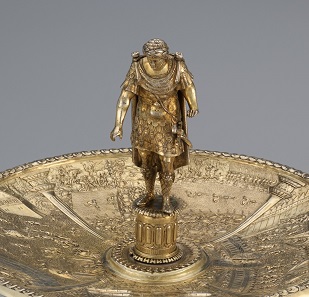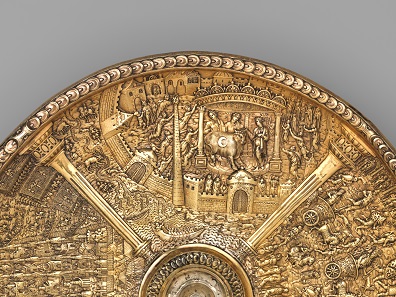March 8, 2018 – The Metropolitan Museum of Arts shows an extraordinary treasure of the Renaissance, the enigmatic Tazze Aldobrandini, a set of 12 silver-gilt standing cups from the 16th century. The exhibition runs until 11 March 2018 in the Robert Lehman Wing, Gallery 955, First Floor. Soon it will move on to Great Britain.
The Vitellius Tazza, c.1587 – c.1599 (figure and dish), 19th century (foot); Netherlands?; silver gilt: The Metropolitan Museum of Art, Fletcher Fund 1945; 9.2018. Photo: © The Metropolitan Museum of Art.
The Aldobrandini Tazze: enigmatic masterwork
The superb technical virtuosity of Renaissance silversmiths is nowhere more evident than in the magnificent set of 12 silver-gilt standing cups from the 16th century known collectively as the Aldobrandini Tazze. Each of the Tazze stands over a foot tall and features a shallow footed dish surmounted by a figure of one of the first 12 Caesars.
The Caligula dish, c.1587 – c.1599: Netherlands?; silver gilt; Casa-Museu Medeiros e Almeida, Lisbon; acc. no. 7.2018. Photo: © The Metropolitan Museum of Art.
On the intricately wrought interior of each dish appear four episodes from the life of the corresponding ruler, as recounted by the Roman historian Suetonius. Although the Tazze are among the finest and rarest examples of 16th-century European silverwork, little is known about their creation.
The Otho Tazza (detail), c.1587 – c.1599 (figure and dish), 19th century (foot); Netherlands?; silver gilt; Royal Ontario Museum, Toronto, from the Collection of Viscount and Viscountess Lee of Fareham, given in trust by the Massey Foundation; acc. no. 8.2018. Photo: © The Metropolitan Museum of Art.
The questions of when, where, why, for whom, and by whom these splendid luxury objects were made are addressed in the exhibition ‘The Silver Caesars: A Renaissance Mystery’.
Julius Caesar’s invasion of Britain (detail from the Julius Caesar dish), c.1587 – c.1599; Netherlands?; silver gilt; Museo Lázaro Galdiano, Madrid; 1.2018. Photo: © The Metropolitan Museum of Art.
The complete set has not been seen together since the mid-19th century, when it was disassembled and dispersed, its constituent parts misidentified and mismatched. In addition, the elements of all 12 Tazze are displayed in their original configuration – a unique opportunity for modern viewers to appreciate one of the most enigmatic monuments of in the work of 16th-century goldsmiths.
Titus visiting Egypt (detail from the Titus dish), c.1587 – c.1599; Netherlands?; silver gilt; Museu Nacional de Arte Antiga, Lisbon; acc. no. 11.2018. Photo: © The Metropolitan Museum of Art.
The exhibition is made possible by The Schroder Foundation, Selim K. Zilkha, the Anna-Maria and Stephen Kellen Foundation, Nina von Maltzahn, and an anonymous donor.
Livia and her infant son Tiberius escape a forest fire (detail from the Tiberius dish), c.1587 – c.1599; Netherlands?; silver gilt; Victoria and Albert Museum, London, Dr. W. L. Hildburgh Bequest; acc. no. 12.2018. Photo: © The Metropolitan Museum of Art.
The Renaissance views of ancient Rome
The Silver Caesars highlight the elegance and astonishing erudition of the Tazze, presenting them with a small selection of other works in silver and other media, including both ancient and Renaissance coins and medals and Renaissance prints, books, and paintings.
Titus’s Roman triumph (detail from the Titus dish), c.1587 – c.1599; Netherlands?; silver gilt; Museu Nacional de Arte Antiga, Lisbon; acc. no. 11.2018. Photo: © The Metropolitan Museum of Art.
The exhibition considers such topics as 19th-century views of the Renaissance and Renaissance views of ancient Rome. Examples of 19th-century works that the Tazze inspired are included. In addition to offering new insights into the Tazze and their history, the exhibition explores the set’s famously mysterious reputation – engaging the visitor in tracing clues that may lead to a better understanding of this Renaissance masterpiece.
Within the exhibition, a digital component featuring high-resolution photography of two Tazze enables visitors to explore these works and their fantastic antiquarian imagery in greater depth.
The exhibition’s curator Julia Siemon and Mary Beard, Professor of Classics, University of Cambridge, gave a lecture on the story of the Aldobrandini Tazze.
Following its presentation at The Met, from April 18 through July 22, 2018 the exhibition will be on view at Waddesdon Manor, Buckinghamshire.
And if you want to learn more about these enigmatic objects, don’t miss the Met’s blog articles ‘Decoding the Silver Caesars’ Part One and Part Two.











